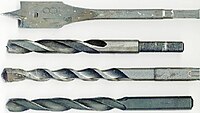
Photo from wikipedia
Abstract Press hardened steels are commonly used as a lightweight choice for manufacturing car components because of the high ratio of strength to weight. The use of ultra-high-strength steels for… Click to show full abstract
Abstract Press hardened steels are commonly used as a lightweight choice for manufacturing car components because of the high ratio of strength to weight. The use of ultra-high-strength steels for the design of lightweight vehicles contributes to the reduction of emissions of carbon dioxide while maintaining passenger safety. Stamping tools used in press hardening processes suffer harsh contact conditions in terms of dramatic temperature changes, cyclic loadings, and complex interactions between coatings and oxidation. In mass production, tool wear is an inevitable problem that increases maintenance costs. Severe adhesive wear, also called galling, substantially occurs in the stamping tool used against Al—Si-coated workpieces. The galling that takes place during press hardening not only degrades the production quality but also shortens the service life of the tool. In order to properly arrange tool maintenance and minimize galling through adjusting process parameters, engineers need to know when and where galling occurs, based on modelling of the galling in press hardening simulations. In order to implement a galling simulation for press hardening, a modified Archard wear model is employed in the present study, which is a contact-mechanics-based model. The specific wear rate in the model is calibrated by the quantitative galling measurements of a high-temperature tribometer test. The tribological test is designed to mimic the press hardening conditions, where the correlations between galling and process parameters such as temperature, pressure, and sliding distance are outlined. The galling simulation is implemented in a full-scale press hardening experiment, and the predicted galling is validated in terms of severe galling positions and galling profiles. The galling profile evolution is correlated to variations in the contact conditions. Uncertainties in the numerical model, such as the choice of penalty scaling factor and friction coefficient, are analysed with a parameter study and discussed. This study demonstrates finite element (FE) simulations involving galling prediction in press hardening so as to improve product development and production efficiency.
Journal Title: Engineering Failure Analysis
Year Published: 2019
Link to full text (if available)
Share on Social Media: Sign Up to like & get
recommendations!